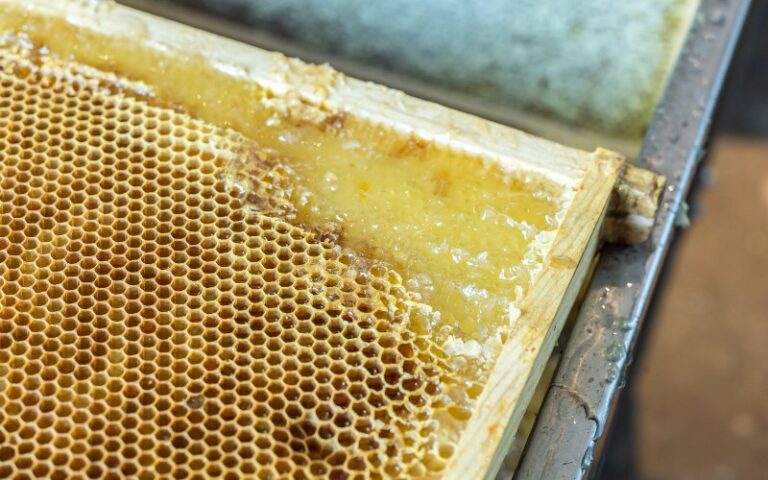Can You Eat Uncapped Honey? (Answer + Tips)
I’ve been terrified of getting stung for as long as I can remember. However, I’m a sucker for honey, and once I got past the fear, beekeeping has been one of the most enjoyable parts of homesteading for me. There’s something about the incredible teamwork and harmony you find in a hive that’s fascinating; and of course, honey raised in the backyard somehow always tastes better than any honey you can buy from the store.
If you’re like me, you want to get out of your bees’ personal space as soon as possible when you’re harvesting honey. If that’s the case, it’s difficult to be picky about only selecting frames with capped honey. But those uncapped frames are full of delicious, dripping sweetness – and you’re wondering if you can eat it. The answer is probably yes – but you’ll want to be careful.

Can You Eat Uncapped Honey – Is It Safe? (The Short Answer)
Uncapped honey contains too much moisture to be cured and capped by the bees. If it’s stored, it may end up fermenting in the jar – and while fermented honey is usually safe to eat, it tastes different. The honey will taste normal if the majority of a frame is capped, it passes the shake test, or it’s just been harvested.
Uncapped Honey Shake Test: How to Tell If It’s Edible or Not
For bees, part of the process of creating honey involves dehydrating it to about 80 percent sugar. Bees can only cap honey after it reaches this level. So honey that’s not capped might still have high moisture levels, which means you shouldn’t store it either.
The honey shake test is a simple way to find out if your honey is ready to be stored for later consumption.
- Lay out a large piece of butcher paper or parchment paper near your hive.
- Hold the uncapped frame upside-down over the paper.
- Shake the frame a few times or bump it against something. Essentially, try to shake the honey out of the cells.
- Check how much honey is on the paper. If you find no more than a few drops, the honey is ready to be stored.
- If a lot of honey drips out, you can go ahead and put the frame back in the hive. The bees will either use it for food during the winter or finish dehydrating and capping it.
Don’t worry too much about whether or not your honey is safe to eat – it takes a lot for honey to go bad. Fermented honey is completely edible and some recipes call for it. Also, just because honey hasn’t reached the proper moisture levels doesn’t necessarily mean it will ferment. Once, when cleaning out the basement of a house, my dad found five gallons of honey along with quarts upon quarts of 30-year-old canned food. The owner didn’t want any of it, and the food had all gone bad – except the honey. Well, honey is expensive, so we ate all of it. It tasted great!
3 Steps to Prep Uncapped Honey For Consumption
You can eat uncapped honey, but you’ll want to be careful when it comes to storage.
Shake Test Any Uncapped Frames
Give any uncapped frames a quick shake test to make sure they’re ready to store. Frames that don’t pass the test should be put back in the hive for the bees to eat or finish curing. If that’s not an option or you want to try fermented honey, you can take the risk and extract them as usual.
Eat As Comb Honey
If you’re not sure if the frames are ready to harvest or not, you always have the option to simply eat the honeycomb. I love to chew on the comb, so every time I harvest honey, I make sure to save some honeycomb to eat “as is”.
Since storage is the biggest problem with uncapped honey, it will be fine if you plan on eating it within a few weeks. The same goes for both honeycomb and extracted honey.
Extract The Honey
If the frames pass the shake test, go ahead and extract the honey as normal. You can purchase a honey extractor or simply do it with things you have. I usually cut the honeycomb off the frames and mash it as much as possible in a pan. Next, I run it through a cheesecloth and squeeze out as much honey as I can into a large bowl. It’s then ready to be put in honey jars and stored.
Does Uncapped Honey Taste Different?
Uncapped honey that wasn’t ready for storage might ferment over a period of time. Fermented honey may taste slightly alcoholic and have a bready smell. You may also be able to see bubbles or foam in the honey and the jar might make a popping sound as you open it. Fermented honey can still be eaten, and if you like sweet fermented foods, try fermenting fruit with honey.
If you eat uncapped honey before it has a chance to ferment, it should taste like normal honey. Uncapped honey is basically honey that has too much moisture in it, and moisture really doesn’t affect the taste.
Uncapped honey that passes the shake test will taste just the same as capped honey. It doesn’t have the necessary moisture to ferment.

